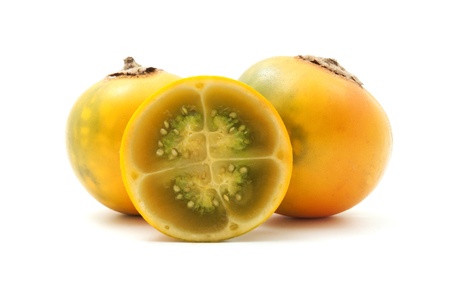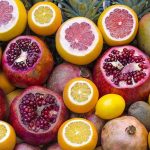
The Naranjilla or Lulo (Solanum quitoense, Lam. Syn. S. anulatum, Family: Solanaceae) is not a fruit likely to be found on the shelves in the UK but it has been extremely popular in countries such as Ecuador and Columbia where it was first recorded in the 17th Century (Heisner & Anderson, 1999). the fruit is native to most countries in southern America, especially the Andes and goes by several names. It is lulo in Colombia but in the USA, Ecuador and Panama it is naranjilla.
It is colloquially known as the “the golden fruit of the Andes” and ‘the nectar of the gods”. It has the potential to be one of the top fruits for product development in beverages (Dennis & Herner, 1985; NRC, 1989) and there is a good description of the plant and fruit at the Purdue University web-site.
The plants are susceptible like all Solanum species to various diseases and this particular one has not transplanted itself well to other countries. Commercially, it is grown in the USA and tropical environments.
Description
The Naranjilla looks like a citrus fruit in many respects and grows on a small tree with shrub-like appearance. A number of cultivars have been developed to improve its cold adaptation.
The fruit is round with a peel covered with brittle hairs. During ripening, naranjilla turns from green to orange. The fruit is climacteric, with a relatively low respiration rate even during the climacteric peak
Taste And Flavour
It has a distinctive tart, tangy, almost citrus flavour. Various cultivars have different flavour as well as nutrition properties.
It has a distinctive aroma similar to pineapple, with lime, banana, strawberry, lemon and rhubarb characters which was analysed by Brunke et al., (1989) by GC-MS with olfactory characterisation. One of the key components which is found in all these other fruits just mentioned is methyl butanoate which is a common ester and partly explains why pineapple is picked up.
A number of C-13 norisoprenoid glycosides are found in both fruit and leaves (Osorio et al., 2003).
The fruit is also rich in carotenes and lutein (Gancel et al., 2008) and other bioactives (Acosta et al., 2009).
Nutrition
Considered a healthy and highly popular juice drink because of its good vitamin range and said to rival tomato and other Solanum products. The juice is green which offers some interesting product development opportunities. The main vitamins to note are vitamin A, vitamin C (12.5mg), thiamine, riboflavin, and niacin. The minerals are calcium, iron, phosphorous. There is a small amount of dietary fibre. Typically, no fats !
Antioxidants: The H-ORAC value of naranjilla which is a key measure of antioxidant value, was higher than those of banana, cantaloupe, honeydew, kiwi fruit, nectarine, pineapple, and watermelon (among others); similar to those of red grapefruit, navel orange, peach, pears, and tangerine; but lower than those of apples, cherry, plums, and all berries (Wu et al., 2004) on a weight basis. The polyphenolic contents are similar to banana, lemon and pineapple (Brat et al., 2006).
The carotene content: 0.71-2.32 μg /g (Morton, 1987) and 2.212 μg / g the in edible portion (Guzman et al., 1977).
It’s worth noting that a number of web-sites underplay the antioxidant and polyphenolic contents, preferring to focus solely on the vitamin C levels. The vitamin C levels vary between different cultivars. The range can be from 37.5 (Guzman et al., 1977), 47.5 (22), and 95 mg/ 100 g (2) for Colombian and Ecuadorian naranjilla samples.
References
Acosta, O., Perez, A., Vaillant, F., (2009) Chemical characterization, antioxidant properties, and volatile constituents of naranjilla (Solanum quitoense Lam.) cultivated in Costa Rica. Archivos Latinoamericanos de Nutricion 59, pp. 88–94
Arango, H., Vaillant, F., Velez, C., Millan, P., Reynes, M. (1999) Evaluation of post-harvest performance of naranjilla (Solanum quitoense Lam.) fruits packed under modified atmosphere. Fruits. 54 pp. 261-70
Brat, P., George, S., Bellamy, A., Du Chaffaut, L., Scalbert, A., Mennen, L, et al. (2006) Daily polyphenol intake in France from fruit and vegetables. J. Nutr. 136: pp. 2368-73.
Brunke, E-J, Mair, P., Hammerschmidt, F-J. (1989) Volatiles from naranjilla fruit (Solanum quitoense Lam.). GC/MS analysis and sensory evaluation using sniffing GC. J. Agric. Food Chem. 137 pp.746-8.
Dávila J. (1982) Industrialización de la naranjilla. Politécnica. 7: pp. 137-58.
Dennis, F. G. J.; Herner, R. C. (1985) Naranjilla: a potential cash crop for the small farmer in Latin America. Acta Hortic. 158, pp. 475–481.
Gancel, A. L.; Alter, P.; Dhuique-Mayer, C.; Ruales, J.; Vaillant, F. (2008) Identifying Carotenoids and Phenolic Compounds In Naranjilla (Solanum quitoense Lam. Var. Puyo Hybrid), an Andean Fruit. J. Agric. Food Chem. 56, pp. 11890–11899
Guzmán, R., De Villaveces, M.C., De Clavijo, E. (1977) Estudio de la composición química del lulo (Solanum quitoense Lam.) y obtención de un producto comercial a partir de este fruto. Frutas Trop. Bol. Informativo. pp. 59-69.
Heiser, C. B.; And erson, G. (1999) “New” Solanums. In: Perspectives on new crops and new use; Janick, J., Ed.; ASHS Press: Alexandria, VA, USA. pp 379-384
Morton, J.F. (1987)Naranjilla. In: Morton J.F., editor. Fruits of warm climates. Florida: Creative Resource Systems/ pp. 425-8.
NRC (National Research Council) (1989) In: Lost Crops of the Incas: Little-Known Plants of the Andes with promise of the world cultivation. National Academy Press: Washington, USA. pp 267-275.
Osorio, C., Duque, C., Batista-Viera, F. (2003) Studies on aroma generation in lulo (Solanum quitoense): enzymatic hydrolysis of glycosides from leaves. Food Chem., 81(3) pp. 333-340
Suárez, M., Duque, C., Bicchi, C., Wintoch, H., Full, G., Schreier, P. (1993) Volatile constituents from the peelings of lulo (Solanum vestissimum D.) fruit. Flavour Fragr. J. 8: pp. 215-20
<
p align=”LEFT”>Wu, X., Beecher, G.R., Holden, J.M., Haytowitz, D.B., Gebhardt, S.E., Prior, R.L. (2004) Lipophilic and hydrophilic antioxidant capacities of common foods in the United States. J. Agric. Food Chem. 52 pp. 4026-37.



PLS SEND ME A RECIPE FOR MAKING NARANJILLA {GOLDEN FRUIT OF THE ANDES} JAM
– I AM GROWING LOTS OF ABOVE IN POTS AND WOULD LIKE TO MAKE JAM……….
– TKS IN ADVANCE – KIND REGARDS,PETER………..